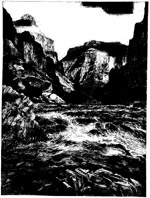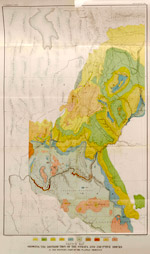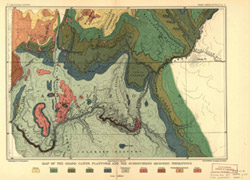Throughout our past, rivers have expanded commercial and manufacturing opportunities, influenced settlement patterns and acted as boundaries—effectively shaping the history, politics and geography of nations across the globe.
The U.S. Congressional Serial Set illustrates the important role of rivers through its collection of more than 50,000 maps, many in full color. In addition to its vast number of U.S. maps, the Serial Set includes maps from locales as widely scattered as Asia, South America and the Yukon Territory.
It seems all rivers have a story to tell. Here are several, as told from the pages of the Serial Set.
Colorado River
The Colorado River is formed by the junction of the Grand and the Green Rivers. The Grand River (officially renamed the Colorado in 1921) has its source in Grand Lake in the Colorado Rocky Mountains; while the Green's source is located near Fremont Peak in the Wind River Mountains of Wyoming. These two great rivers join in Canyonlands National Park in Utah and flow south before emptying into the Gulf of California.
Including the Green, the whole length of the Colorado River is about 2,000 miles. Its watershed is the size of Minnesota, Wisconsin, Iowa, Illinois and Missouri combined. There are two distinct portions of the basin of the Colorado. The upper two-thirds of the basin run through gorges at the four to eight thousand foot level, flowing through mountains that are eight to fourteen thousand feet above sea level. Winter comes early and snow falls to great depths at this level. When the summer sun shines, this snow melts and water cascades down mountain sides, swelling the river into great torrents.
The lower third of the river is barely above sea level and flows through mountains that reach an altitude of two to six thousand feet. The valley through which it flows is bounded on the north by a line of cliffs that form plateaus hundreds and thousands of feet above the river. On its lower course, the river winds through arid lands where it forms part of the Arizona border with Nevada and California. It finally flows through part of Mexico and empties into the Gulf of California.
The first recorded trip down the Colorado River from the junction of the Green and Grand Rivers in Utah and through the Grand Canyon in Arizona was made in 1869 by John Wesley Powell and a small exploring party. Powell's journals reveal his party's excitement and anxiety as they entered the Grand Canyon:
"We are three quarters of a mile in the depths of the earth, and the great river shrinks into insignificance, as it dashes its angry waves against the walls and cliffs, that rise to the world above; they are but puny ripples, and we but pigmies, running up and down the sands, or lost among the boulders.1

Woodcut from a photograph by Thomas Moran who accompanied
J.W. Powell on one of the expeditions of the Colorado River
"At the very introduction, it inspires awe. The canyon is narrower than we have ever before seen it; the water is swifter; there are but few broken rocks in the channel; but the walls are set, on either side, with pinnacles and crags; and sharp, angular buttresses, bristling with wind and wave polished spires, extend far out into the river."2
The river descends seventy five or eighty feet in a short distance, the roiling water breaking into great waves on the rocks, creating a "mad white foam." As the river rushes through the granite gorge, this scenario plays out over and over again. "The walls, now, are more than a mile in height—a vertical distance difficult to appreciate," Powell writes.3
"A thousand feet of this is up through granite crags, then steep slopes and perpendicular cliffs rise, one above another, to the summit. The gorge is black and narrow below, red and gray and flaring above, with crags and angular projections on the walls, which, cut in many places by side canyons seem to be a vast wilderness of rocks. Down in these grand, gloomy depths we glide, ever listening, for the mad waters keep up their roar; ever watching, ever peering ahead, for the narrow canyon is winding, and the river is closed in so that we can see but a few hundred yards, and what there may be below we know not; but we listen for falls, and watch for rocks, or stop now and then, in the bay of a recess, to admire the gigantic scenery."4

eruptive rocks in the western part of the Plateau Province.
The geology represented in the canyon walls is said to include all the layers that are found in all the rest of the country. Indeed, one of the most significant contributions of the Powell expeditions (he went three times) was the geological data gathered. A geological map showing the distribution of the strata and eruptive rocks in the western part of the Plateau Province was published in the Serial Set a number of years later. Appearing in Monographs of the United States Geological Survey, Vol. II., Tertiary history of the Grand Canon district, with atlas, by Clarence E. Dutton, is a Map of the Grand Canyon Platform and the surrounding Mesozoic formations.

the surrounding Mesozoic formations.
Lena River
Flowing northward to the Laptev Sea, the Lena River in Asian Russia is one of the longest rivers in the world. The Lena River Delta is approximately 250 miles wide, and because the river is so far north, its waters are frozen for much of the year. The Lena holds several distinctions, including the important role it played in the United States' Jeannette Expedition of 1879-1881.5

The USS Jeannette, commanded by Lt. George W. DeLong, was sent to explore the Arctic and the North Pole. On June 12, 1881, the ship was crushed by ice and abandoned by its crew. Towing three boats, the crew started across the ice to the Lena River Delta. Two of the boats, under the command of DeLong and George W. Melville, managed to arrive at the Delta—but not together. DeLong's party went down the Lena in search of native villages and all but two crewmembers died in the attempt. Melville's party was able to survive only because they located native Inuit people near the Delta. Several rescue expeditions were made, most by the United States and at least one by the Imperial Russian Geographic Society.6

the routes of the rescue party (1881-1882).
The U.S. Congressional Serial Set contains a map that depicts details of the Jeannette Expedition and rescue expeditions. Also shown are the Lena River and Delta; tracks of DeLong's and Melville's crews; tracks of relief parties; locations of native villages; dog routes; and the locations of DeLong's and crewmembers' deaths and burial cairns.
Orinoco and Essequibo Rivers
Rivers, by their very nature, have always been natural boundaries, and historically, whoever holds the mouth of the river may also claim its watershed. This principle—in combination with the geography of the Orinoco and Essequibo rivers in northeastern South America—has played a vital role in the history and development of several New World colonial territories.
The U.S. Congressional Serial Set contains maps of Guiana, Dutch Guiana and Spanish Guiana, often written in Dutch, Spanish, German, Latin, French and English and often containing intriguing annotations. Through them, one can discover the stories of the Orinoco and Essequibo rivers.

One of the earliest maps of the region found in the Serial Set is Theodore De Bry's 1599 map of Guiana, which offers a detailed sketch of the area from the Amazon Basin north to the Orinoco River and includes illustrations of native animals and people. It was commonplace for 16th, 17th and 18th-century cartographers to place names of indigenous peoples (e.g., Caribes and Arawaks) along their maps of riverbanks in Guiana. N. Sanson D'Abbeville's 1656 map of Guiana and Caribana and William Deslisle's 1703 map are further examples of this.

by Governor Storm Van's Gravesande, 1748.
The history of the region, as detailed by its maps, can be traced from the Colonial era through publications by The Dutch West India Company, a competitive trading enterprise with vital interests in the region. When the Company needed maps of the Dutch colony of Essequibo in 1706, they turned to surveyor Abraham Maass, whose maps show land settlement patterns along the bank of the Essequibo River. Then, in 1748, the Company was presented with a map from the Governor of the colony, Storm Vans Gravesande, depicting Fort Zeelandia and a number of plantations. The Dutch held their possessions in the vicinity of the Essequibo River until 1814, when the Congress of Vienna awarded the lands of the Essequibo, Demerara and Berbice rivers to Great Britain. Thus, in 1815, British Guiana was created.
Within the Serial Set, there are also several maps of Spanish Guiana, located mostly in and upriver from the Orinoco Delta in what today is Venezuela. These maps, published between 1735 and 1789, depict Orinoco-area missions, including a 1735 map of Catalonian Capuchin missions in the Spanish Province of Guayana that includes distances between missions and notes on indigenous peoples. Because many of the missions were abandoned or relocated as natives fled to the interior, the maps that represent them serve as visual reminders of the cultural heritage of northeast South America.
Although Serial Set maps offer an illustrated record of Spanish and British Colonial history in northeast South America, the maps' historical value becomes most evident in the late 19th century, when a lingering boundary controversy existed between the modern-day nations of Venezuela and Guyana. The United States had interests in the area and was concerned about preserving its peace and stability. In 1895, President Grover Cleveland invoked the Monroe Doctrine and authorized the formation of the Venezuelan Boundary Commission (VBC) to arbitrate land claims between the two countries. The VBC did so by collecting and deciphering documents, reports, archives and, most importantly, maps that detailed the historical boundaries of colonial occupation.7

Compiled under the direction of the Commission
appointed "to investigate and report upon the true
divisional line between the Republic of Venezuela
and British Guiana." Washington, D.C. 1897.
Additionally, the Venezuelan Boundary Commission compiled their own collection of maps (1897) which represents a historical record of the European occupation in the vicinity of the Orinoco and Essequibo rivers. These maps are arranged chronologically and provide a detailed visual history of the region complete with dates of treaties; locations of military forts, missions, ruins, plantations and boundaries; and geographical features of the Orinoco and Essequibo river basins.8
Yukon River
U.S. Congressional Serial Set maps related to the Yukon River include those from the Alaska Military Reconnaissance of 1883, the U.S. Army Exploration to Cook's Inlet (1898-1899) and many geological surveys by explorers in search of gold, copper, iron, timber and other natural resources.
Lieutenant Frederick Schwatka led the Alaska Military Reconnaissance of 1883. His party travelled from Chilcoot Inlet, Alaska to the Apoon Mouth of the Yukon River. Schwatka's report of the expedition includes a set of 20 maps, organized by Schwatka into three parts based on geographic locations. Part 1 covers Chilcoot Inlet to Fort Selkirk; Part 2, Fort Selkirk to Fort Yukon; and Part 3, Fort Yukon to the Yukon River Delta.
The U.S. Army Expedition to Cook's Inlet was led by Lieutenant Joseph S. Herron. His exploring party travelled overland from Cook Inlet on the Pacific Ocean to the Yukon. The expedition's report contains one map that includes the route followed with dates indicating where the party was and when; the topography of the land; Indian trails; heads of navigation for various rivers; portages; and the location of the military reservation at Fort Gibbon on the Yukon River.

The Yukon River was also an important route to the Klondike during the Klondike Gold Rush (1896-1899). Many potential miners arrived at Skagway and took the Chilcoot Trail or hiked through the White Pass to arrive at the headwaters of the Yukon River. There, they built watercraft to carry them and their supplies down the Yukon to Dawson City near the gold fields. Among many Serial Set maps related to natural resources and the Yukon Territory is a beautifully colored one depicting the gold district and routes to the headwaters of the Yukon River.9
***
Beyond their contributions to navigation and exploration, maps serve as graphic reminders of a region's history, people and politics. The maps of the U.S. Congressional Serial Set illustrate the physical features of land and waterways around the world and—through accompanying journals and sketches—offer insight into the people, culture and times that produced them.
Footnotes:
1 Report of J.W. Powell. Exploration of the Colorado River of the West and its tributaries. Explored in 1869, 1870, 1871, and 1872, under the direction of the Secretary of the Smithsonian Institution. Serial Set 1622, House Document 300, p. 80.
2 Ibid., p. 81.
3 Ibid., p. 83.
4 Ibid., p. 83.
5 "Jeannette Arctic Expedition, 1879-1881." 29 October 2003. Dept. of the Navy, Naval Historical Center. 30 December 2008. http://www.history.navy.mil/photos/events/ev-1880s/jeannett.htm
6 "Lena." Merrian-Webster's Geographical Dictionary. 3rd ed. c2001.
7 "Message from the President of the United States, Relative to the Venezuelan Boundary Controversy; and Correspondence with the British Government on the Subject. December 17, 1895." Serial Set Vol. No. 3347, Session Vol. No.1, 54th Congress, 1st Session S.Doc. 31
8 "Report of the Special Commission Appointed by the President January 4, 1896, to Examine and Report upon the True Divisional Line between the Republic of Venezuela and British Guiana, Transmitted by the President of the Senate on January 21, 1898, with Reports from the Secretary of State and the Acting Secretary of the Treasury." Serial Set Vol. No. 3597, Session Vol. No.8, 55th Congress, 2nd Session, Senate Doc. 91 pt. 3
9 "Klondike Gold Rush, Yukon Territory, 1897." Adventure Learning Foundation. 30 December 2008. http://www.questconnect.org/ak_klondike.htm




